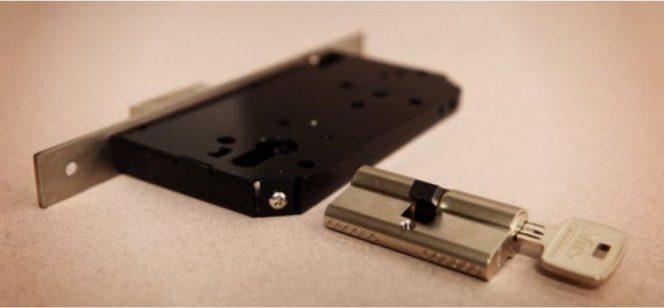The term “lock” is commonly used to mean the entire mechanism which, by using a key, is able to open and close a door.
In reality this is only partly correct. There are, in fact, locks which actually consist of a single mechanism, like the majority of the double bit locks.
Generally, however, the locking systems consist of 2 separate devices: the lock and the cylinder.
It is very easy to distinguish them:
• The lock is the most bulky component and it is the one which usually contains the dead-bolt and the latch which, with the door closed, enter the counter-plate present on the jamb in order to prevent the opening. There are many types of locks, depending on the particular use: just with a latch or just with a dead-bolt, with dead-bolt or swing hookbolt, with more than one dead-bolt to control more than one locking point, to be inserted or to be applied, manual, electrical or electronic, set up for a handle or not … and many other variants. There are also a wide range of shapes and sizes, in order to satisfy every need.
• The cylinder, on the other hand, is the smallest component, which is inserted inside the lock. Its function is substantially that of receiving the key and, if this is the correct one, transferring the rotational movement of the key to the mechanism of the lock. There are also many different types of cylinders, and one of the advantages of using a system consisting of lock + cylinder is that of being able to select both the components in such a way that they best satisfy the specific needs case by case. However, not all the cylinders can be fitted on all the locks. The locks to be applied often have cylinders different from those to be inserted and in this latter case the cylinder must have an outer profile which is compatible with the housing present on the lock. The most common profiles are the European one, the round one and the oval one.

The lock and cylinder are two different mechanisms which complement each other and both contribute to the overall security of the door. It is therefore important to choose them so that the composition is balanced.It makes no sense to install a high security cylinder on a weak lock, or a poor quality cylinder on a high-end lock. The lock must be able to withstand attacks with brute force, whilst the cylinder must be able to also cope with the various techniques such as lock picking or key bumping.
As well as allowing a careful selection of the two components, the use of a lock with a separate cylinder also allows only one of the two parts to be changed. This may be necessary if one of the two has a fault, but especially if one wishes to update it with the latest available technologies, developed for withstanding burglary techniques which develop over time.
If there is a sector in which the research and development never stops, this is unfortunately that of the thieves and burglars, who are constantly in search of new techniques to overcome the existing security systems. Fortunately, not even the manufactures give up, and innovation in the sector of locks and security systems is generally constant. For this reason, a cylinder or a lock which could have been considered secure some years ago might not be so today. Fitting a cylinder + lock system allows updating of just the cylinder, which is the component which develops most rapidly, saving both in terms of material and manpower, since replacing just the cylinder is a much simpler and faster operation than replacing the entire lock.
Therefore, distinguishing between lock and cylinder is not only a lexical question, but a means of considering the security for what it truly is: the result of several factors which must work in coordination with each other.


